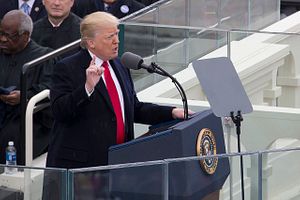Donald J. Trump is now president of the United States, one known for his “America First” position. What impact might that have on disputes in the South China Sea?
On December 4, 2016, the president-elect tweeted, in reference to China’s construction of artificial islands for military purposes in the South China Sea, “Did China ask for our permission?” Still, it is premature to conclude that Trump will really take a harder line on China than the Obama administration has over the South China Sea issue. The tweet may simply have been Trump firing back at China for criticizing his telephone conversation with Taiwanese President Tsai Ing-wen two days earlier. Also, China’s seizure of a U.S. Navy’s underwater drone in the South China Sea later that month was not a sufficient test of Trump’s South China Policy, although he criticized the incident on Twitter.
From the very beginning of his presidential campaign, Trump has viewed China not through a national security lens, but primarily as an economic competitor and as a challenge. He sees China as a currency manipulator that is taking jobs and wealth away from Americans through an increasing trade deficit. He also accuses China of stealing industrial secrets through cyberattacks and thinks that if the U.S. eliminates the trade deficit with China and applies economic pressure, China will stop reclaiming reefs in the South China Sea.
Yet Trump simultaneously does not appear to be a believer in the Thucydides trap (which posits that confrontation between an emerging power and an existing power is inevitable). He has said that he would aim for peaceful coexistence with China and seek to build relations based on common interests. This is not incompatible with the “new type of major country relations” which China has been calling for under President Xi Jinping.
The top foreign policy priority for the Trump administration will be containing Islamic extremists such as the Islamic State. Trump has said he will significantly expand U.S. military power, increasing the Army’s numbers from 490,000 to 540,000, fighter jets from 1,113 to at least 1,200, Marines from 23 battalions to 36 battalions, and surface vessels and submarines in the U.S. Navy from 276 to 350.
It is not yet clear what policy the Trump administration will take with respect to the South China Sea and what role this expanded military force will play in the region. The Chinese leadership is perhaps the most keen to know. China has a history of testing the crisis response capabilities of incoming U.S. administrations. In April 2001, soon after the inauguration of the administration of George W. Bush, a Chinese fighter jet collided with a U.S. EP-3 reconnaissance airplane over international waters off Hainan Island, which severely strained relations. At that time, China demanded an apology from the United States and succeeded in drawing an expression of regret from the Bush administration. In March 2009, soon after Barack Obama had taken over the presidency, Chinese warships, government-owned vessels and fishing vessels obstructed the navigation of USNS Impeccable, an ocean surveillance ship, in the South China Sea. The Obama administration responded by dispatching the guided missile destroyed USS Chung-Hoon to protect the Impeccable.
So it would not be at all surprising if China were to try some kind of provocation once Donald Trump takes office. Since China saw its claims to the South China Sea voted down by the International Court of Arbitration based on the U.N. Convention of the Law of the Sea, Beijing has ostensibly been refraining from provocative acts. But it has continued to build facilities on the artificial islands it has created.
Rather than the South China Sea, China could test the Trump administration and the strength of the U.S.-Japan alliance in the East China Sea. This would no doubt please Philippines President Rodrigo Duterte, who has been keen to make overtures to China. Alternatively, Beijing may target Taiwan, to punish Tsai for her phone call with Trump in addition to the recent demonstration deployment of its aircraft carrier in the South China Sea.
The Trump administration could avoid a major rupture in U.S.-Sino relations by responding rationally to any provocation, while emphasizing freedom of navigation and the peaceful resolution of conflicts. It could also go too far in its response, and put itself on the path to confrontation. Or perhaps it will tacitly condone China’s domination of the South China Sea in exchange for the elimination of the trade deficit, placing the emphasis on the peaceful coexistence of the two countries.
Whichever path it takes, Trump’s response to the likely Chinese provocations will become a major factor in determining the future of the South China Sea.
Tetsuo Kotani is Senior Fellow at The Japan Institute of International Affairs.

































